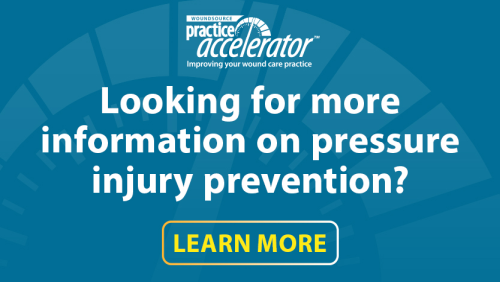Assessment and Interventions for Present-on-Admission Pressure Injuries
October 31, 2020
Pressure injuries are among the most significant health and patient safety issues that health care facilities face daily. Aside from the strong impact on patients’ quality of life, they also have high costs of treatment, not just to the patient, but also to the health care industry. The Agency for Healthcare Research and Quality reported $20,900 to $151,700 per individual patient and pressure injury in health care costs.1
The prevalence of present-on-admission (POA) pressure injuries is 26.2% among those admitted to the hospital from a nursing home and 4.8% among those admitted from another living setting.2 Hospital-acquired pressure injuries (HAPIs) cost the US health care system $9.1 to $11.6 billion a year.1 The epidemiology of pressure injuries varies by clinical setting, and pressure injury is a potentially preventable condition.
Florence Nightingale wrote in 1859, “If he has a bedsore, it’s generally not the fault of the disease, but of the nursing.” This quote indicates fault in the nursing team, but clinicians have discovered over time that other reasons may be considered. However, there remains a gap in education and the health care system. Nursing staff members play a vital role in risk assessment, skin care, prevention, mechanical loading, and patient and staff education. Research suggests that teamwork by health care providers can decrease incidence rates of pressure injuries.1,3
Present-on-Admission (POA) Pressure Injuries
The Centers for Medicare and Medicaid Services define “present on admission” as present at the time of the order for inpatient admission. Conditions considered in the POA definition include pressure injuries that develop in an outpatient encounter such as in the emergency department, during observation, or during outpatient surgery.2
Admission to the hospital from a nursing home has been deemed a potent marker because these patients are mostly older and thus have a higher prevalence and a higher risk of pressure injuries.4 This population is more likely to have chronic conditions that lead to limited mobilization.5 Therefore, common risk factors such as limited mobilization and incontinence suggest that nursing home residents have a higher prevalence of pressure injury compared with persons living in a community setting.6
Hospital-Acquired Pressure Injuries and In-House Pressure Injuries
The Joint Commission, which is a global driver of quality improvement, considers the development of a stage 3 and 4 pressure injury as a patient safety event that could be a sentinel event. This is an event that occurs while in the hospital or in health care settings. In 2008, The Centers for Medicare & Medicaid Services announced that it will not pay for additional costs incurred for HAPIs (then referred to as pressure ulcers).7
High-risk populations such as older adults and persons with chronic conditions are at an increased risk of pressure injury because of the use of medical devices, the presence of hemodynamic instability, and the use of medications such as vasoactive agents.8 It is vital for health care professionals to perform a head-to-toe skin check on all patients on admission to prevent POA pressure injuries from being incorrectly documented as HAPIs.
How much do you know about pressure injury prevention? Take our 10-question quiz to find out! Click here.
Risk Assessment
Prevention and early identification of pressure injuries are paramount in addressing skin injury for better outcomes. Use a comprehensive risk assessment tool that includes identification of existing pressure injuries and other chronic contributing factors. Repeat the assessment on a regular basis, and make changes to the care plan as needed based on the risk assessment findings. Remember, patients who have already developed one pressure injury are at increased risk of developing another.
Skin Care
Good skin care is vital in the care and management of skin, but it is also an additional strategy in monitoring and assessing the skin. Inspect and assess the skin from head to toe on admission and daily. Focus extra attention on pressure points and skin underneath any medical devices (i.e., briefs, tubing, splints). Always consider skin tones when assessing skin; pressure injuries on darker skin tones will not look the same as those on lighter skin tones. Use good lighting and take your time. Consistent incontinence care is critical in protecting the pH of the skin and preventing maceration. Use skin cleansers that are pH balanced and use moisturizers after bathing.
Positioning and Mobilization
Nursing staff should avoid positioning patients on bony prominences or on any previous or current pressure injury. An important factor in pressure injury development is immobility, but risk factors also include age, poor health conditions, paralysis, sedation, and coma. Utilize positioners, protectors, and offloading devices as available. Wedges, pillows, and foams can be used as appropriate. Turning and repositioning are recommended every two hours and as needed or tolerated. Consider pressure redistribution support surfaces and high-end wheelchair cushions. Equipment used should always be based on the patient’s body weight, body size, and level of immobility to ensure that equipment is appropriate to prevent further pressure and/or shear.
Nutrition
A valid screening tool for risk should be used on every patient. Hospital patients are at greatest risk for undernutrition. Patients at risk for pressure injury should always be referred to a registered dietitian or nutritionist. Regularly monitor weight and oral, enteral, and parenteral intake to address any nutritional deficiencies. Consider additional nutritional supplements such as a high-potency multivitamin, arginine drink boxes or powders, and protein supplements (puddings, ice cream, powders, foods) as indicated to help assist in wound healing for patients with nutritional deficiencies.
Documentation
Documentation provides not only the “proof” of care but also a way to report wound progress and healing outcomes. A wound assessment and monitoring system and wound measurement devices are ways to optimize documentation standards. Wound measurement devices include skin markers, tracing materials, and flow sheets to measure wound surface area and support photograph consistency. Wound assessment and monitoring systems are technologies used to measure, capture images, and document wounds. Many systems are integrated with electronic medical record software. This allows facilities to generate quality indicator reports and more.
Education and Training of Staff
Educating and training staff member consistently bolster quality of care. Continuous monitoring and leadership support will provide best outcomes for both the patients and teamwork spirit in the facility. Good communication among team members is key in implementation of a pressure injury prevention program. Make educational times interactive and fun to optimize educational sessions. By increasing staff education, staff will be better able to catch and document POA pressure injuries and prevent them from being incorrectly documented as HAPIs.
Conclusion
When it comes to POA pressure injuries and HAPIs, all the difference is made in the initial head-to-toe skin inspection. By performing these early checks, health care providers can ensure proper injury documentation and put appropriate interventions in place to prevent further tissue degradation. It is also important to recognize those patients at increased risk of pressure injury development so prevention methods can be used to prevent HAPI development.

References
1. Preventing pressure ulcers in hospitals. Rockville, MD: Agency for Healthcare Research and Quality; 2014. https://www.ahrq.gov/patient-safety/settings/hospital/resource/pressure… Accessed October 23, 2020.
2. Olivo S, Canova C, Peghetti A, Rossi M, Zanotti R. Prevalence of pressure ulcers in hospitalised patients: a cross-sectional study. J Wound Care. 2020;29(Suppl 3):S20-S28.
3. Lyder CH, Ayello EA. Pressure ulcers: a patient safety issue. In: Hughes RG, editor. Patient Safety and Quality: An Evidence-Based Handbook for Nurses. Rockville, MD: Agency for Healthcare Research and Quality; 2008. https://www.ncbi.nlm.nih.gov/books/NBK2650/. Accessed October 22, 2020.
4. Allman RM, Goode PS, Burst N, Bartolucci AA, Thomas DR. Pressure ulcers, hospital complications, and disease severity: impact on hospital costs and length of stay. Adv Wound Care. 1999;12(1):22-30.
5. Fried TR, Mor V. Frailty and hospitalization of long-term stay nursing home residents. J Am Geriatr Soc. 1997;45(3):265-269.
6. Murtaugh CM, Freiman MP. Nursing home residents at risk of hospitalization and the characteristics of their hospital stays. Gerontologist. 1995;35(1):35-43.
7. Cooper KL. Evidence-based prevention of pressure ulcers in the intensive care unit. Crit Care Nurse. 2013;33(6)57-66.
8. The Joint Commission. Quick safety 25: preventing pressure injuries. https://www.jointcommission.org/resources/news-and-multimedia/newslette…. Accessed September 28, 2020.
The views and opinions expressed in this blog are solely those of the author, and do not represent the views of WoundSource, HMP Global, its affiliates, or subsidiary companies.












Follow WoundSource
Tweets by WoundSource